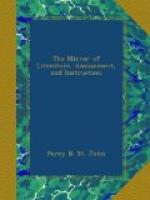“I envy no quality of the mind or intellect in others; not genius, power, wit, or fancy: but if I could choose what would be most delightful, and I believe most useful to me, I should prefer a firm religious belief to every other blessing; for it makes life a discipline of goodness—creates new hopes, when all earthly hopes vanish; and throws over the decay, the destruction of existence, the most gorgeous of all lights; awakens life even in death, and from corruption and decay calls up beauty and divinity: makes an instrument of torture and of shame the ladder of ascent to paradise; and, far above all combinations of earthly hopes, calls up the most delightful visions of palms and amaranths, the gardens of the blest, the security of everlasting joys, where the sensualist and the sceptic view only gloom, decay, annihilation, and despair!”
Few of those whose fame and fortune are their own creation, enjoy, as did Sir Humphry Davy, in the meridian of life, the enviable consciousness of general esteem and respect, and the certainty of a distinguished place in history, among the illustrious names of their country. “A great light has gone out,”—short but brilliant has been his career; yet let us hope he has but exchanged his worldly fame for unearthly immortality, to shine amidst the never-dying lights of true glory.
[1] This apparatus is of immense power, and consists
of 200
separate parts, each part
composed of ten double plates, and each
plate containing 32 square
inches. The whole number of double plates
is 2,000, and the whole surface
126,000 square inches.
[2] Memoir—New Monthly Magazine, Vol.
I. Mr. Dillon has lately invented
an Improved Safety Lamp,
an Engraving of which will be found at
page 137, Vol. XII. of
the MIRROR.
[3] It deserves notice, that two of the most illustrious
philosophers of
our times, Sir H. Davy and
Dr. Wollaston, have died within the
present year.
[4] Extract of a Letter from Geneva, dated June 1, 1829—Times.
[5] These experiments, the last which engaged Sir
Humphry Davy’s
attention to any extent, were
on the application of electrical
combinations, for the purpose
of preserving the copper sheathing of
ships’ bottoms.
To this subject Sir Humphry gave much of his time,
and personally inspected all
the boats and vessels on which the
trials were made. Although
the theory upon which they were conducted
proved eminently correct,
no advantage could be ultimately taken of
the plans which it suggested.
The saving of the copper was wholly
counterbalanced by an accumulation
of shell-fish and sea-weed on the
sheathing, which became sufficient,
in a short time, to prevent the
proper command of the ship
at the helm.
[6] Abridged in the Arcana of Science and Arts for 1829.
[7] Salmonia, 1st. Edition, page 161.
Several beautiful Extracts from
which, will be found in Vol.
XII. of the MIRROR.




